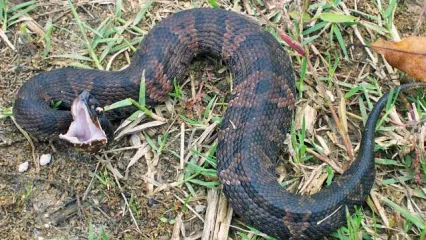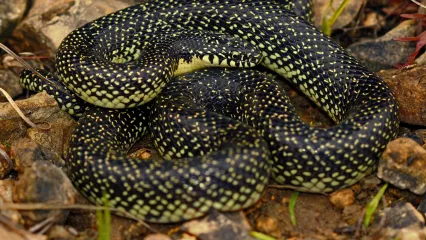
Description
A combination of size (1 – 4-foot total length), heavily keeled scales, a black triangular-shaped head, dark brown to nearly black coloration with indistinct suggestion of even darker cross markings, and elliptical, catlike pupils in the eyes distinguish northern cottonmouths from other snakes. Like other pit-vipers, scales under the tail are complete rather than divided. Although juvenile northern cottonmouths superficially resemble copperheads, the snakes can be distinguished by a combination of the shape of dorsal cross bands and coloration on the ventral surface. Dorsal cross bands of copperheads are narrow along the spine (some may be broken) and at least twice as wide at the bottom of the lateral surface of the body (hour-glass shaped) whereas bands on juvenile northern cottonmouths are only slightly wider along the bottom of the lateral surface of the body. Moreover, the edges of the bands on copperheads are very distinct whereas those on juvenile northern cottonmouths are jagged. The ventral surfaces of both northern cottonmouths and copperheads contain rectangular dark markings against a lighter background. However, these markings are in two distinct rows and are black or very dark brown in northern cottonmouths. Finally, juvenile northern cottonmouths have a distinct yellow line that extends from the top of the eye across the top of the snout. Copperheads lack this line.
Size
Large adult northern cottonmouths reach just over four feet in total length, but most individuals encountered are two to three feet in total length. They appear larger than they are because they are heavily bodied.
Habitat
Northern cottonmouths are usually associated with water and they are good swimmers. They are particularly common in large swamps associated with rivers, but can be common along small streams, in ponds, and even in lakes. During summer, individuals often wander away from water and can be found on the forest floor.
The distribution of northern cottonmouths in the United States extends west to east from central southern Oklahoma through North Carolina and north to south from southeastern Missouri to the tip of Florida.
Life Cycle
Similar to other pit-vipers, northern cottonmouths are late-maturing, long-lived, and reproduce repeatedly during their lives. Sexual maturity likely is reached at an age of 4 – 6 years when individuals reach about 20 inches in snout to vent length. Individuals likely live 20 years or more. Females produce litters of 4 – 7 live young (more in eastern United States populations) in late summer or early fall. Newborn young are about 10 inches in total length.
Although it is a popular belief that cottonmouths drop from trees overhanging water into boats, these snakes rarely climb and they do not bask out on tree limbs as do several species of watersnakes. Usually, snakes mistaken for cottonmouths are plain-bellied watersnakes, which bask on tree limbs and will drop off (expecting to hit the water) when disturbed. Other watersnakes also do this.
Northern cottonmouths are active from early spring through late fall. They often aggregate in late fall and enter overwintering “dens,” usually consisting of cavities in the ground (not made by the snakes) at the base of large trees. They may also aggregate in beaver dens as some watersnakes do. During spring and fall, these snakes are generally diurnal, but much of their activity occurs at night during summer. Cottonmouths eat nearly every imaginable vertebrate that they can capture, including fish, rodents, birds, small mammals, frogs, lizards, and snakes. They occasionally eat dead animals, and it is not uncommon to see these snakes eating dead fish in ponds as they dry up.
Northern cottonmouths can frequently be found along the edges of streams, ponds, and lakes where they lie coiled, often under the edge of shrubs. In spring and fall, they often bask in sunny spots along streams and shores of ponds and lakes. They are active at night during summer and can be observed by wading just offshore and searching the shoreline with good lights. Adults frequently move away from water and can sometimes be found on hillsides or in forests near streams and lakes. When disturbed, northern cottonmouths often coil with their head in the center of the coils and open their mouth exposing the nearly white interior of the mouth, hence the name “cottonmouth.”
These snakes are often common where they occur. Loss of wetlands and development along streams and lakeshores are likely the greatest threat to this species, Similar to many other venomous snakes, northern cottonmouths are often killed simply because they are venomous. As a result, their numbers diminish as the density of housing increases in rural areas.
How To Observe
Cottonmouths are highly venomous snakes and should be observed with caution. It is best to not handle or disturb these snakes.
(This profile was created by Dr. Laurie Vitt as part of a partnership between the Wildlife Department and the Sam Noble Oklahoma Museum of Natural History. It was funded as part of a larger State Wildlife Grant to survey and inventory amphibians and reptiles of the Wildlife Management Areas of Oklahoma: T-35-P-1.)


